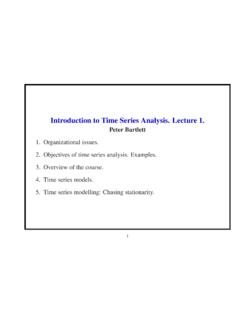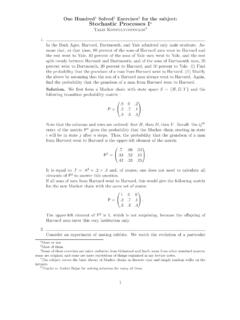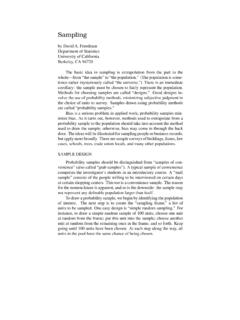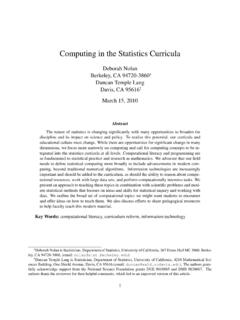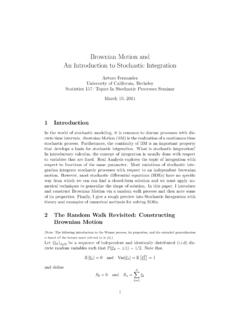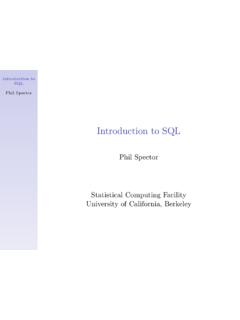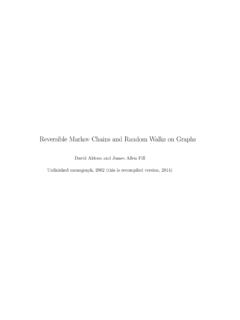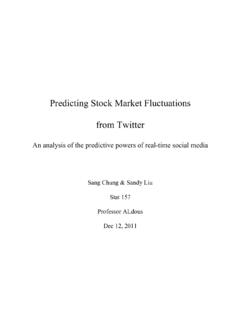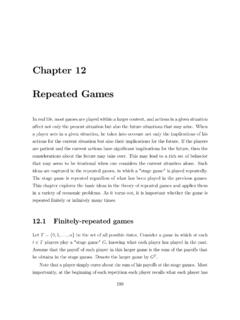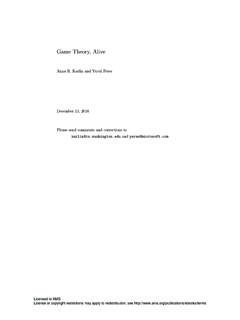Transcription of Lecture Notes for Introductory Probability
1 Lecture Notes for Introductory ProbabilityJanko GravnerMathematics DepartmentUniversity of CaliforniaDavis, CA 9, 2011 These Notes were started in January 2009 with help from Christopher Ng, a student inMath 135A and 135B classes at UC Davis, who typeset the Notes he took during my text is not a treatise in elementary Probability and has no lofty goals; instead, its aim isto help a student achieve the proficiency in the subject required for a typical exam and basicreal-life applications. Therefore, its emphasis is on examples, which are chosen without muchredundancy. A reader should strive tounderstandevery example given and be able todesignand solvea similar one. Problems at the end of chapters and on sample exams (the solutionsto all of which are provided) have been selected from actual exams, hence should be used as atest for have only one tip for studying Probability :you cannot do it half-heartedly.
2 You have todevote to this class several hours per week of concentrated attention to understand the subjectenough so that standard problems become routine. If you think that coming to class and readingthe examples while also doing something else is enough, you re in for an unpleasant surprise onthe text will always be available free of charge to UC Davis students. Please contact me ifyou spot any mistake. I am thankful to Marisano James for numerous corrections and 2010, Janko Gravner1 INTRODUCTION11 IntroductionThe theory of Probability has always been associated with gambling and many most accessibleexamples still come from that activity. You should be familiar with the basic tools of thegambling trade: a coin, a (six-sided) die, and a full deck of 52 cards. A fair coin gives you Heads(H) or Tails (T) with equal Probability , a fair die will give you 1, 2, 3, 4, 5, or 6 with equalprobability, and a shuffled deck of cards means that any ordering of cards is equally are typical questions that we will be asking and that you will learn how toanswer.
3 This example serves as an illustration and you should not expect to understand how toget the answer with a shuffled deck of cards and distribute all 52 cards to 4 players, 13 cards to is the Probability that each player gets an Ace? Next, assume that you are a player andyou get a single Ace. What is the Probability now that each player gets an Ace?Answers. If any ordering of cards is equally likely, then any position of the four Aces in thedeck is also equally likely. There are(524)possibilities for the positions (slots) for the 4 aces. Outof these, the number of positions that give each player an Ace is 134: pick the first slot amongthe cards that the first player gets, then the second slot among the second player s cards, thenthe third and the fourth slot. Therefore, the answer is134(524) you see that you have a single Ace, the Probability goes up: the previous answer needsto be divided by the Probability that you get a single Ace, which is13 (393)(524) The answerthen becomes13413 (393) is how you can quicklyestimatethe second Probability during a card game: give thesecond ace to a player, the third to a different player ( Probability about 2/3) and then the lastto the third player ( Probability about 1/3) for the approximate answer 2/9 of probabilityAlthough gambling dates back thousands of years, the birth of modern Probability is consideredto be a 1654 letter from the Flemish aristocrat and notorious gambler Chevalier de M er e to themathematician and philosopher Blaise Pascal.
4 In essence the letter said:I used to bet even money that I would get at least one 6 in four rolls of a fair Probability of this is 4 times the Probability of getting a 6 in a single die, ,4/6 = 2/3; clearly I had an advantage and indeed I was making money. Now I beteven money that within 24 rolls of two dice I get at least one double 6. This has thesame advantage (24/62= 2/3), but now I am losing money. Why?As Pascal discussed in his correspondence with Pierre de Fermat, de M er e s reasoning was faulty;after all, if the number of rolls were 7 in the first game, the logic would give the nonsensicalprobability 7/6. We ll come back to this INTRODUCTION2 Example a family with 4 children, what is the Probability of a 2:2 boy-girl split?One common wrong answer:15, as the 5 possibilities for the number of boys are not common guess: close to 1, as this is the most balanced possibility.
5 This repre-sents the mistaken belief that symmetry in probabilities should very likely result in symmetry inthe outcome. A related confusion supposes that events that are probable (say, have probabilityaround ) occur nearly likely outcomesSuppose an experiment is performed, withnpossible outcomes comprising a that all outcomes are equally likely. (Whether this assumption is realistic depends on thecontext. The above Example gives an instance where this is not a reasonable assumption.)AneventEis a set of outcomes, ,E S. If an eventEconsists ofmdifferent outcomes(often called good outcomes forE), then the Probability ofEis given by:( )P(E) = fair die has 6 outcomes; takeE={2,4,6}. ThenP(E) = does the answer in Example mean? Every student of Probability should spendsome time thinking about this.
6 The fact is that it is very difficult to attach a meaning toP(E)if we roll a die a single time or a few times. The most straightforward interpretation is that fora very large numberof rolls about half of the outcomes will be even. Note that this requiresat least the concept of a limit! Thisrelative frequencyinterpretation of Probability will beexplained in detail much later. For now, take formula ( ) as the definition of COMBINATORICS32 CombinatoricsExample three fair coins. What is the Probability of exactly one Heads (H)?There are 8 equally likely outcomes: HHH, HHT, HTH, HTT, THH, THT, TTH, TTT. Outof these, 3 have exactly one H. That is,E={HTT, THT, TTH}, andP(E) = 3 us now compute the Probability of a 2:2 boy-girl split in a four-childrenfamily. We have 16 outcomes, which we willassumeare equally likely, although this is not quitetrue in reality.
7 We list the outcomes below, although we will soon see that there is a better conclude thatP(2:2 split) =616=38,P(1:3 split or 3:1 split) =816=12,P(4:0 split or 0:4 split) =216= two dice. What is the most likely sum?Outcomes are ordered pairs (i, j), 1 i 6, 1 j of outcomes2132435465768594103112121 Our answer is 7, andP(sum = 7) =636= COMBINATORICS4 How to count?Listing all outcomes is very inefficient, especially if their number is large. We will, therefore,learn a few counting techniques, starting with a trivial, but conceptually important principle of counting. If an experiment consists of two stages and the first stage hasmoutcomes, while the second stage hasnoutcomes regardless of the outcome at the firststage, then the experiment as a whole a die 4 times. What is the Probability that you get different numbers?
8 At least at the beginning, you should divide every solution into the following three steps:Step 1: Identify the set of equally likely outcomes. In this case, this is the set of all ordered4-tuples of numbers 1, .. ,6. That is,{(a, b, c, d) :a, b, c, d {1, .. ,6}}.Step 2: Compute the number of outcomes. In this case, it is therefore 3: Compute the number of good outcomes. In this case it is 6 5 4 3. Why? Wehave 6 options for the first roll, 5 options for the second roll since its number must differfrom the number on the first roll; 4 options for the third roll since its number must notappear on the first two rolls, etc. Note that thesetof possible outcomes changes fromstage to stage (roll to roll in this case), but theirnumberdoes not!The answer then is6 5 4 364=518 us now compute probabilities for de M er e s Game 1, there are 4 rolls and he wins with at least one 6.
9 The number of good events is64 54, as the number ofbadevents is 54. ThereforeP(win) = 1 (56)4 Game 2, there are 24 rolls of two dice and he wins by at least one pair of 6 s rolled. Thenumber of outcomes is 3624, the number of bad ones is 3524, thus the number of good outcomesequals 3624 3524. ThereforeP(win) = 1 (3536)24 de M er e overcounted the good outcomes in both cases. His count 4 63in Game1 selects a die with a 6 and arbitrary numbers for other dice. However, many outcomes havemore than one six and are hence counted more than should also note that both probabilities are barely different from 1/2, so de M er e wasgamblinga lotto be able to notice the COMBINATORICS5 PermutationsAssume you havenobjects. The number of ways to fillnordered slots with them isn (n 1)..2 1 =n!,while the number of ways to fillk nordered slots isn(n 1).
10 (n k+ 1) =n!(n k)!.Example a deck of cards. P(top card is an Ace) =113=4 51!52!. P(all cards of the same suit end up next to each other) =4! (13!)452! 10 28. This eventnever happens in practice. P(hearts are together) =40!13!52!= 6 10 compute the last Probability , for example, collect all hearts into a block; a good event isspecified by ordering 40 items (the block of hearts plus 39 other cards) and ordering the heartswithin their we go on to further examples, let us agree that when the text sayswithout furtherelaboration, that a random choice is made, this means thatall available choices are equallylikely. Also, in the next problem (and in statistics in general)sampling with replacementrefersto choosing, at random, an object from a population, noting its properties, putting the objectback into the population, and then without replacementomits the puttingback bag has 6 pieces of paper, each with one of the letters,E,E,P,P,P, andR, on it.

